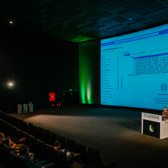Team Development with Azure DevOps
utfs
3 days
Interested in a private company training? Request it here.
Azure DevOps Services
What is Azure DevOps? Who is it for? What is the big picture?
- Azure DevOps: The big picture
- Features
- The Extensions Marketplace
- LAB: Register for an Azure DevOps Account
Azure DevOps Team Projects
Azure DevOps is the collaboration hub for everyone in the development team, including project managers, testers, architects, developers and end-users. Here we will create a team project and configure it.
- Development Processes
- Team Projects and Process Templates
- LAB: Creating and configuring your team project
- LAB: Customizing your process
Using Git
Sources are probably the most important part in any software project and we need a way to keep track of all sources and all changes. Azure Repos gives you the choice between TFVS and Git for storing your source history, branching, merging and everything else required. Here we discuss Git source control.
- Version Control concepts
- Distributed Source Control with Git
- Git Clients: Command Line, Visual Studio or Visual Studio Code
- Creating a local repository
- Configuring your git repository
- Checking the status of your repo
- Staging files
- Committing files, and then amending it
- Comparing changes in files
- Reverting commits
- Using Git Hooks
- Using Aliases to Customize your Experience
- Finding the bad change using git bisect
- LAB: Working with a local repository
Team collaboration with remote repositories
Multiple developers working on the same code base requires a central place for all your team's code and changes. In Git these are known as remote repositories. Here we discuss team collaboration with Git.
- Team collaboration with remote repositories
- Cloning a remote repository
- Synchronizing with a remote repository
- Resolving Git Pull conflicts
- LAB: Working with remote repositories
Working in isolation with branches
How can we avoid code changes from one developer interfering with code from others? Branching has always been used to allow developers to complete their changes before integrating them with others.
- Adding branches to your workflow
- Branching Strategies - Using GitFlow
- Merge vs. Rebase - keeping a linear history
- Different Merge Strategies, i.e. Squash Merge
- Managing your branches
- LAB: Working with branches in git
Team Collaboration with Pull Requests
Working as a team on the same codebase comes with its own challenges. Factors like false cognates, code conventions, SOLID principles, etc., could result in good or bad code quality. Pull requests allow you to ensure that your code maintains its high quality.
- Protecting your branches with pull requests
- Ensuring high quality code with Pull Requests
- Versioning with Git Tags
- Using Forks
- LAB: Team collaboration with Pull Requests
Project Management with Azure Boards
The project backlog contains all the features that users have requested. This does not mean we will immediately add this feature; for this, we have backlog planning where we try to identify the features we want to build next.
- Iterative Development
- Creating the project backlog
- Work Items and Queries
- Velocity and Forecasting
- LAB: Create your project backlog
Planning a sprint
Once we have decided which features we will build next, we will identify the various tasks that need to be completed to build that feature. We will look at balancing product, schedule, and cost.
- Sprint Planning
- Identifying user stores for the next sprint
- Capacity planning
- Defining tasks to complete a user story
- Adjust work to fit team capacity
- Sharing a sprint with stakeholders
- LAB: Planning the next sprint
Running the sprint
Ready? Set? Go! During the sprint the whole team builds the next features. Communication here is essential, so we will look at the daily standup meeting and how VSTS can help. We will also look at reporting in DevOps.
- Running a sprint
- The daily standup meeting
- Burndown chart
- Team dashboard
- Task integration with source control
- LAB: Starting the sprint
Continuous Integration with Azure Pipelines
To build quality software and to avoid integration problems at the end of the project, continuous integration builds are considered a best practice. Azure DevOps simplifies continuous integration through its pipeline system. Here, you will author build pipelines to ensure the quality of your project.
- Doing Continuous integration
- Introduction to YAML
- Authoring build using the designer and yaml files
- What are stages, jobs, tasks?
- What are build agents?
- Setting up a build agent in your enterprise network
- LAB: Setting up and running a build definition
Continuous Deployment with Azure Pipelines
With continuous deployment, you can automatically deploy your project. By utilizing stages, you can verify the quality of your deployment through manual and/or automatic steps before deploying to production.
- Release management and continuous deployment
- Release definitions
- Integrating with other systems (such as Azure and GitHub) using Service Connections
- Approving releases with release gates
- Choosing between deployment patterns
- LAB: Continous Deployment with a release definition
Infrastructure as Code
The cloud enables you to easily provision computing infrastructure, such as servers, networks, storage, and other resources. With 'infrastructure as code,' you use machine-readable definition files, such as ARM or Bicep, to deploy your infrastructure.
- What is Infrastructure as Code?
- Authoring Bicep Templates
- Deploying Bicep using Azure CLI
- Using Continuous Deployment to create your infrastructure
- LAB: Deploying your application's infrastructure using Azure Pipelines
Azure Artifacts
Modern development utilizes packages like NuGet, NPM, or others. With Azure Artifacts, you can create your own private or public package feeds.
- Understanding Azure Artifacts
- Creating a Package Feed
- Pushing a Package
- Understanding Upstream Sources
- Versioning Packages
- Using Artifacts in Azure Pipelines
Do you want to learn how DevOps can deliver a higher quality software product in less time? How to avoid broken deployments using continuous integration and deployment? Then this course is for you!
Anyone who is involved in application development. Exercices don't require real coding skills as they are for illustrating the workflow with Azure DevOps.








